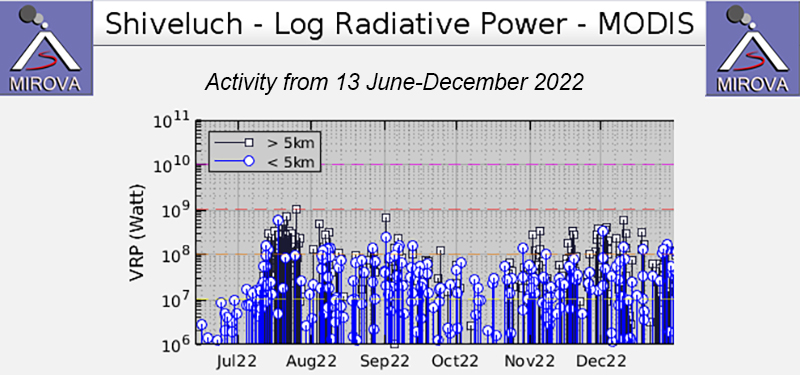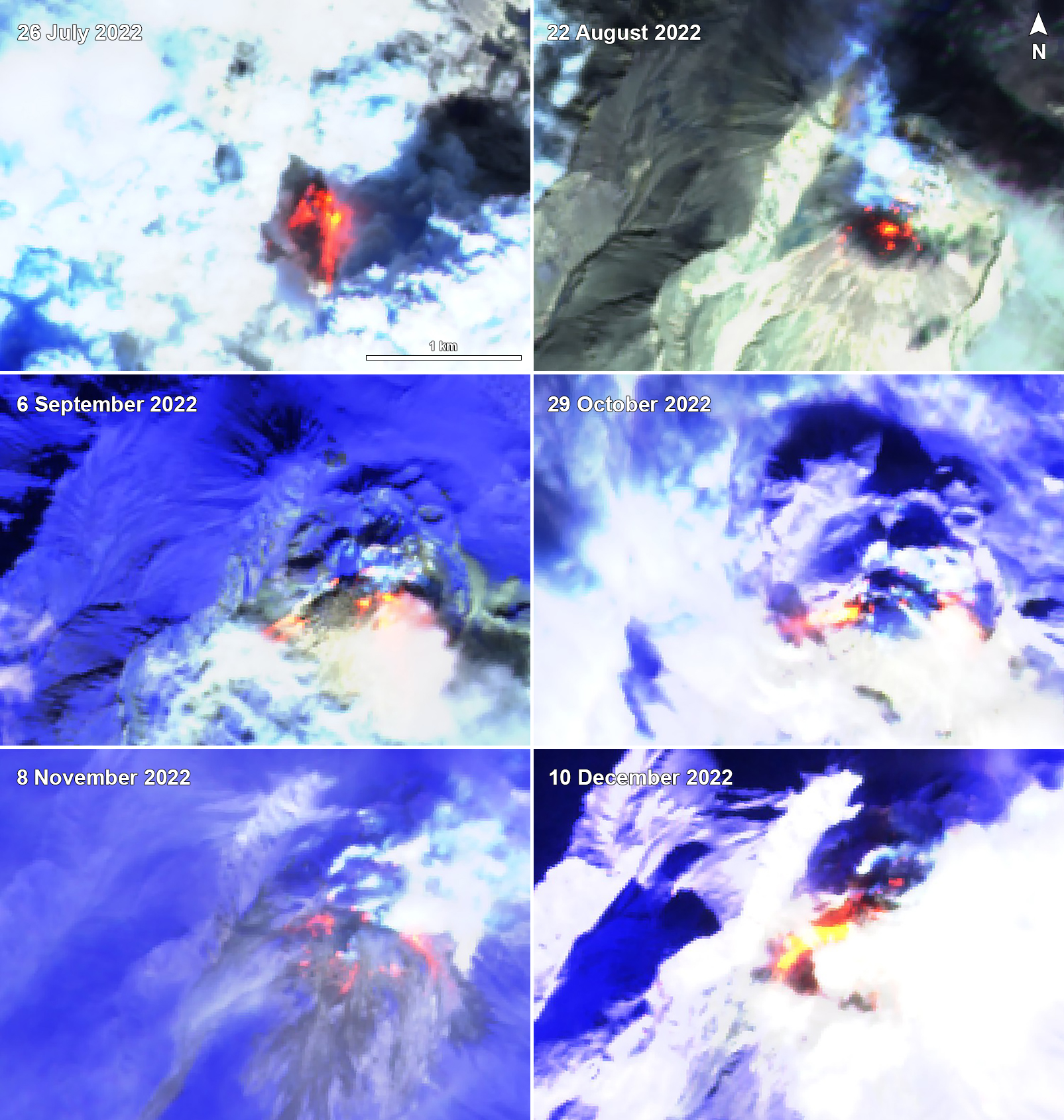Report on Sheveluch (Russia) — January 2023
Bulletin of the Global Volcanism Network, vol. 48, no. 1 (January 2023)
Managing Editor: Edward Venzke.
Edited by Kadie L. Bennis.
Sheveluch (Russia) Continued lava dome growth, explosions, ash plumes, and avalanches during July-December 2022
Please cite this report as:
Global Volcanism Program, 2023. Report on Sheveluch (Russia) (Bennis, K.L., and Venzke, E., eds.). Bulletin of the Global Volcanism Network, 48:1. Smithsonian Institution.
Sheveluch
Russia
56.653°N, 161.36°E; summit elev. 3283 m
All times are local (unless otherwise noted)
Sheveluch (also spelled Shiveluch), located in Kamchatka, has had at least 60 large eruptions during the last 10,000 years. The summit is truncated by a broad 9-km-wide caldera that is breached to the S, and many lava domes occur on the outer flanks. The lava dome complex was constructed within the large open caldera. Frequent collapses of the dome complex have produced debris avalanches; the resulting deposits cover much of the caldera floor. A major south-flank collapse during a 1964 Plinian explosion produced a scarp within which a “Young Sheveluch” dome began to form in 1980. Repeated episodes of dome formation and destruction since then have produced major and minor ash plumes, pyroclastic flows, block-and-ash flows, and “whaleback domes” of spine-like extrusions in 1993 and 2020 (BGVN 45:11). The current eruption period began in August 1999 and has more recently consisted of lava dome growth, occasional explosions, block avalanches, and ash plumes (BGVN 47:07). This report covers activity through July-December 2022 using information from the Kamchatka Volcanic Eruptions Response Team (KVERT) and various satellite data.
Volcanism during this reporting period was relatively consistent and characterized by lava dome growth and incandescence, explosions accompanied by hot avalanches that resulted from collapses on the lava dome, ash plumes, and strong fumarolic activity. According to the MODVOLC Thermal Alerts System, 218 hotspots were detected throughout the reporting period, with 63 recorded in July, 59 in August, 24 in September, 7 in October, 40 in November, and 25 in December. Frequent strong thermal activity was recorded during July through December, according to the MIROVA (Middle InfraRed Observation of Volcanic Activity) graph due to the growing lava dome and hot avalanches (figure 89). These thermal anomalies were also visible in Sentinel-2 infrared satellite images throughout the reporting period, from both the lava dome and flank avalanches (figure 90).
Activity during July consisted of lava dome growth, explosions accompanied by hot avalanches, ash plumes, incandescence from the lava dome, and strong fumarolic activity. Satellite data analyzed by KVERT showed a daily thermal anomaly over the volcano. During 11-13 July satellite and video data showed that ash plumes rose to 4.3-4.5 km altitude and drifted 12-82 km SW and SE. On 16 July an ash plume rose to 4.5 km altitude and extended 50 km E. Video and satellite data from KVERT showed a plume of resuspended ash that rose to 3.5 km altitude and drifted as far as 127 km ESE during 18-19 July. Video data taken on 20 July showed that an ash plume rose to 5 km altitude and drifted 15-65 km E. On 21 July a resuspended ash plume rose to 4.5 km altitude and drifted 65 km SE. During 23-24 July video and satellite data showed that an ash plume rose to 4 km altitude and drifted 25-85 km SSW and SE. On 27 July a gas-and-steam plume containing some amount of ash rose to 5.5 km altitude and drifted 20 km NE. Ash plumes were visible drifting 24 km SW on 31 July.
During August, the lava dome continued to grow, in addition to dome incandescence, explosions, hot avalanches, occasional ash plumes, and strong fumarolic activity (figure 91). A thermal anomaly was visible over the volcano each day during clear weather. During 8-9 August gas-and-steam plumes containing some amount of ash drifted 70 km E and SE. An ash plume drifted 190 km SE on 19 August. A plume of resuspended ash extended 150 km E on 25 August.
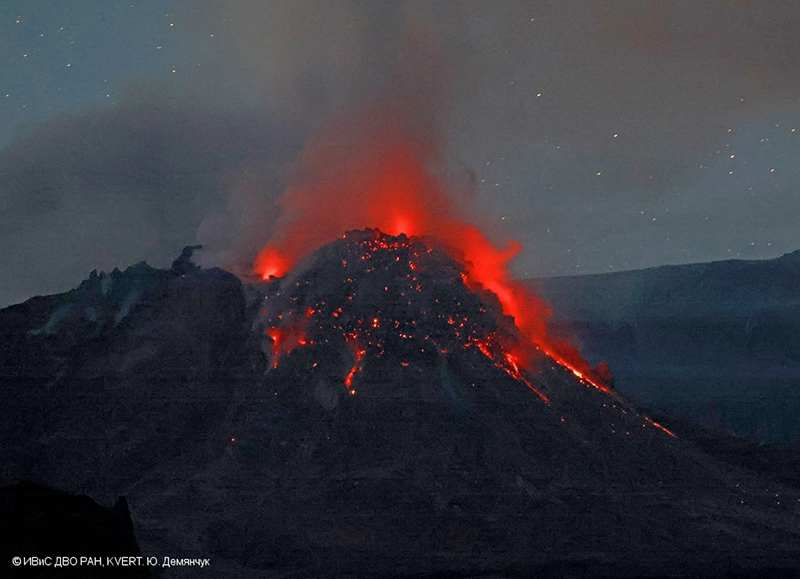 |
Figure 91. Photo of the active lava dome at Sheveluch on 5 August 2022, showing gas-and-steam emissions, dome incandescence, and avalanches. Photo by Yu Demyanchuk, courtesy of IVS FEB RAS, KVERT. |
Dome growth, strong fumarolic activity, dome incandescence, explosions, and associated avalanches were reported during September. A daily thermal anomaly persisted throughout the month. An eruptive plume associated with avalanches drifted 40-70 km E and NE on 1 September. Video and satellite data showed a gas-and-steam plume with some ash that rose to 4.5 km altitude and drifted 42 km NE on 2 September. According to a VONA (Volcano Observatory Notice for Aviation), strong winds during 5 September resuspended ash from the E flank, which rose to 3 km altitude and extended as far as 210 km E and ESE. During 5-7 September ash plumes, caused by avalanches associated with collapses on the lava dome, extended as far as 130 km NE and SE. A gas-and-steam plume containing some ash rose to 4 km altitude on 6 September and drifted 84 km ESE. Video data taken on 6 September showed explosions that generated ash plumes rising 5 km altitude and extending 10 km ESE. On 7 September ash plumes from avalanches on the E flank of the lava dome rose to 4 km altitude and drifted 128 km ESE. A strong wind on 18 September resuspended ash on the E flank that rose to 3 km altitude and drifted 300 km SE. During 21-24 September strong winds lifted ash from the S flank that rose to 3.5 km altitude and drifted as far as 430 km E and 105 km SE.
Activity continued during October with lava dome growth, incandescence in the lava dome, strong fumarolic activity, explosions, and avalanches (figure 92). Satellite data showed a thermal anomaly over the volcano throughout the entire month. Strong winds on 8 October resuspended an ash plume from the S flank which rose to 3 km altitude and extended 105 km E. During 24-25 October ash plumes associated with avalanches extended as far as 80 km SE and NW. On 29 October strong winds generated a resuspended ash plume that rose to 3 km altitude and extended 80 km SE. Collapses of the lava dome on 31 October generated avalanches and ash plumes that drifted 200 km SE.
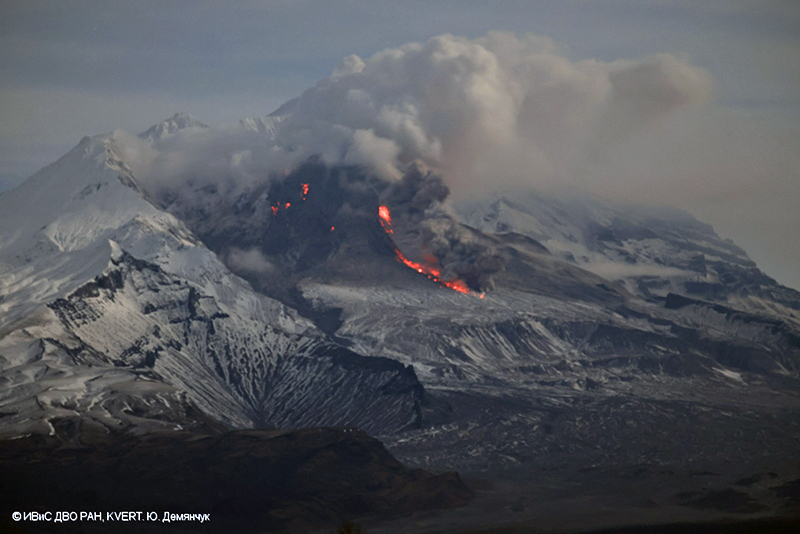 |
Figure 92. Photo of incandescent avalanches descending the growing lava dome at Sheveluch on 11 October 2022 along with associated ash plumes. Photo by Yu Demyanchuk, courtesy of IVS FEB RAS, KVERT. |
Lava dome growth, incandescence, explosions, and strong fumarolic activity were reported during November. Satellite data analyzed by KVERT showed a daily thermal anomaly over the volcano. During 1-2 November hot avalanches on the S and SE flanks generated an ash plume that rose to 3.5 km altitude and drifted 105-210 km ESE. More ash plumes from avalanches during 5-7 November rose to 4 km altitude and drifted as far as 400 km N, NE, and E. The Kamchatka Volcano Station reported that activity notably increased on 5 November; debris avalanches and small pyroclastic flows were visible throughout the day and incandescent avalanches were visible descending SE and SW flanks during the night. On 8 November an ash plume rose to 5.5 km altitude and drifted 25 km ENE. During 13-14, 16-18, 20, 26, and 29 November ash plumes associated with avalanches drifted as far as 90 km NE, ENE, and E (figure 93).
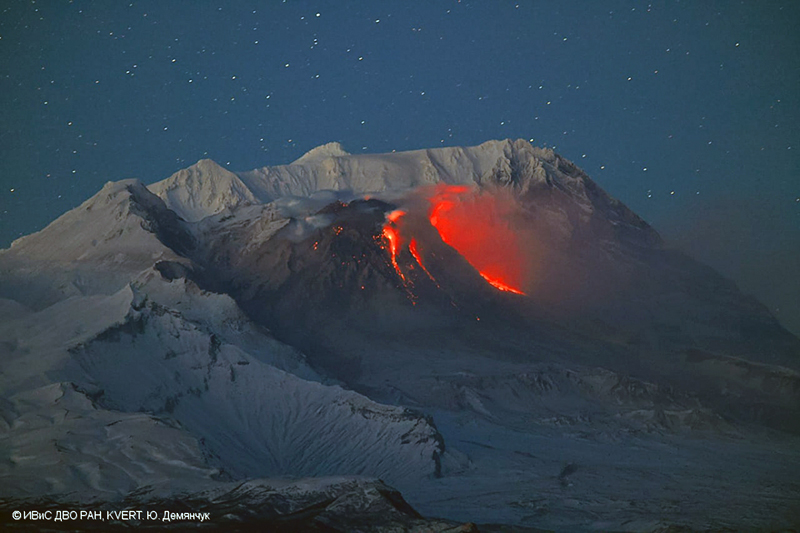 |
Figure 93. Photo of incandescent avalanches originating from the growing lava dome at Sheveluch on 19 November 2022. Photo by Yu Demyanchuk, courtesy of IVS FEB RAS, KVERT. |
During December similar activity was reported, with dome growth, dome incandescence, explosions, strong fumarolic activity, and avalanches. A daily thermal anomaly over the volcano was visible in satellite imagery. An ash plume associated with avalanches on 1 December drifted as far as 90 km NE. During 2-3 and 9 December satellite data from KVERT showed strong gas-and-steam plumes that contained some amount of ash and were associated with avalanches rose to 3-4.5 km altitude and drifted 15-60 km N and NE. Satellite and video data showed that an ash plume rose to 6 km altitude and extended for 90-110 km NE and NNE on 16 December. During 26-29 December gas-and-steam plumes containing some ash rose to 4.5 km altitude and drifted 90 km SW, S, and NE.
Geological Summary. The high, isolated massif of Sheveluch volcano (also spelled Shiveluch) rises above the lowlands NNE of the Kliuchevskaya volcano group. The 1,300 km3 andesitic volcano is one of Kamchatka's largest and most active volcanic structures, with at least 60 large eruptions during the Holocene. The summit of roughly 65,000-year-old Stary Shiveluch is truncated by a broad 9-km-wide late-Pleistocene caldera breached to the south. Many lava domes occur on its outer flanks. The Molodoy Shiveluch lava dome complex was constructed during the Holocene within the large open caldera; Holocene lava dome extrusion also took place on the flanks of Stary Shiveluch. Widespread tephra layers from these eruptions have provided valuable time markers for dating volcanic events in Kamchatka. Frequent collapses of dome complexes, most recently in 1964, have produced debris avalanches whose deposits cover much of the floor of the breached caldera.
Information Contacts: Kamchatka Volcanic Eruptions Response Team (KVERT), Far Eastern Branch, Russian Academy of Sciences, 9 Piip Blvd., Petropavlovsk-Kamchatsky, 683006, Russia (URL: http://www.kscnet.ru/ivs/kvert/); Hawai'i Institute of Geophysics and Planetology (HIGP) - MODVOLC Thermal Alerts System, School of Ocean and Earth Science and Technology (SOEST), Univ. of Hawai'i, 2525 Correa Road, Honolulu, HI 96822, USA (URL: http://modis.higp.hawaii.edu/); MIROVA (Middle InfraRed Observation of Volcanic Activity), a collaborative project between the Universities of Turin and Florence (Italy) supported by the Centre for Volcanic Risk of the Italian Civil Protection Department (URL: http://www.mirovaweb.it/); Sentinel Hub Playground (URL: https://www.sentinel-hub.com/explore/sentinel-playground).


